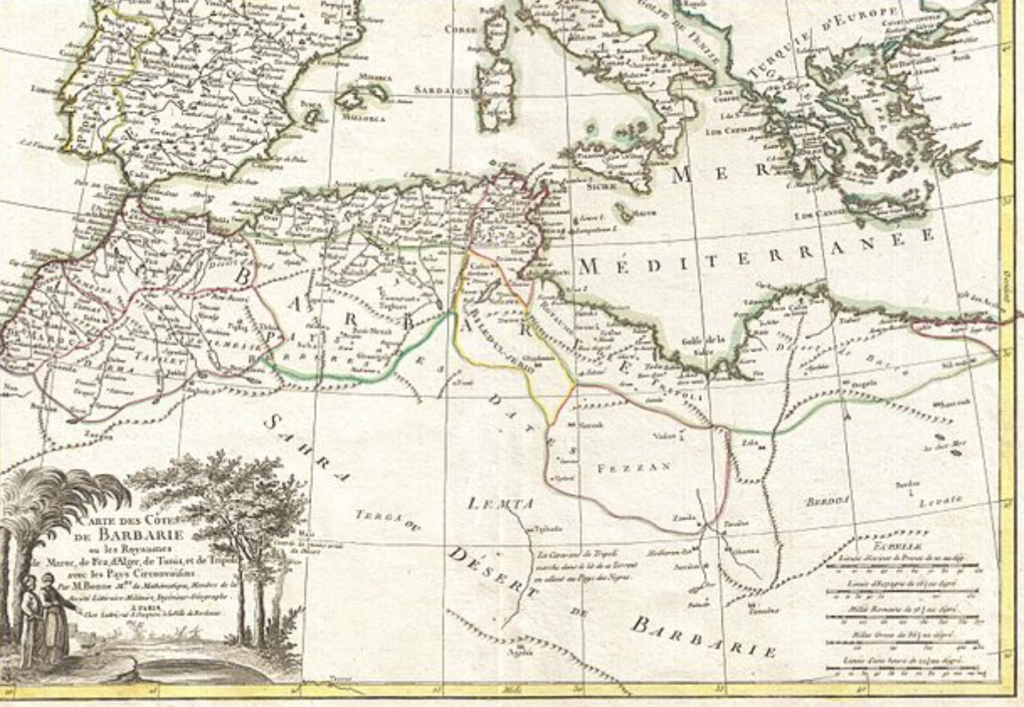Moroccan Pirates and the Barbary Coast: A History of Maritime Intrigue

Bonne Map of the Mediterranean and the Maghreb or Barbary Coast. Photo Source: Wikimedia Commons
By: Rania Basria / Arab America Contributing Writer
The Barbary Coast, that extends over the North African coastlines of modern-day Morocco, Algeria, Tunisia, and Libya, is infamous for being a piracy hotspot from the 16th to the 19th centuries. Rania Basria, a contributing writer for Arab America, discusses Moroccan pirates and how they played an important role in this maritime era, raiding ships, capturing slaves, and confronting the naval forces of Europe and America.
Origins of Barbary Piracy
Barbary piracy originated with the collapse of centralized rule in the Mediterranean during the late Middle Ages. As European nations focused on internal wars and the Ottoman Empire expanded its power, North African coastal cities, notably Moroccan ports like Salé, became safe havens for privateers. These pirates acted with the implicit support of local rulers, who reaped the benefits of their raids.
Piracy flourished in this area due to its strategic location. The narrow Strait of Gibraltar served as a chokepoint for ships traveling between the Atlantic Ocean and the Mediterranean Sea, making it a perfect ambush location for Barbary corsairs.
Moroccan Pirates: The Salé Rovers
Morocco’s contribution to Barbary piracy was concentrated on the city of Salé. Known as the “Salé Rovers,” these pirates were made up of natives, renegade Europeans, and Moorish refugees from Spain. In the early seventeenth century, they established a quasi-independent republic, controlled by a council and led by expert seamen.

The Salé Rovers conducted daring raids on European merchant ships, seizing precious cargo while enslaving sailors and passengers. Slaves were frequently ransomed or sold in North Africa’s bustling markets. Piracy generated wealth for the local economy and strengthened Salé’s position as a pirate stronghold.
European and American Responses
The growth of Moroccan and Barbary piracy established a major threat to European marine trade. Countries such as Spain, France, and England launched military campaigns and signed treaties with Barbary rulers to preserve their maritime routes. These agreements frequently involved paying tribute or ransoming captives, which was a costly endeavor for European nations.
During its early years, the United States had to deal with Barbary pirates. In the late 18th and early 19th centuries, American trade ships were frequently targeted, resulting in the Barbary Wars. The young United States Navy launched operations to defend American interests, culminating in the bombardment of Tripoli in 1804 and the Treaty of Algiers in 1815.
Decline of Barbary Piracy
By the nineteenth century, Moroccan and Barbary piracy had begun decreasing. The advent of powerful European navies, combined with advances in naval technology, made it more difficult for pirates to operate efficiently. The French invasion of Algeria in 1830 brought an end to Barbary piracy, as European powers imposed dominance over North Africa.
Morocco steadily shifted from piracy to diplomacy under Sultan Moulay Abd al-Rahman, integrating into global trade networks and abandoning its role as a corsair haven.
Legacy of the Barbary Pirates
The legacy of Moroccan pirates and the Barbary Coast is still a fascinating chapter in maritime history. Their daring exploits, economic significance, and influence on naval warfare continue to excite both historians and enthusiasts.
From the thriving port of Salé to the diplomatic conflicts of the Barbary Wars, the narrative of Moroccan pirates highlights the long-standing relationship between commerce, strife, and the sea.
Check out our blog here!








